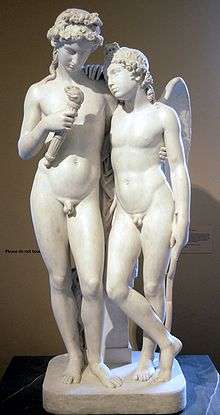George Rennie (sculptor and politician)

George Rennie (1801 or 1802 – 22 March 1860) was a Scottish sculptor and politician. He entered politics to support the arts in Britain and helped achieve free access to public art and museums. He was a Member of Parliament (MP) for Ipswich, 1842-1847. That year he was appointed as governor of the Falkland Islands, off the coast of Argentina.
Early life and education
George Rennie was born to George Rennie, agriculturist, and his wife in Phantassie, East Lothian, Scotland. He was a nephew of John Rennie, the civil engineer. Interested in art from an early age, Rennie studied sculpture at Rome as a young man.
Art career
After his return to Britain, Rennie worked as a sculptor. He exhibited statues and busts at the Royal Academy from 1828 to 1837. He also exhibited three times at the Suffolk Street Gallery during the same period.
His most important works at the academy were: A Gleaner and Grecian Archer, 1828; Cupid and Hymen (depicting Cupid blowing on the torch of Hymen to rekindle its flame) and busts of Bertel Thorvaldsen and his uncle John Rennie, 1831. Also considered of merit are The Archer (which he afterwards presented to the Athenaeum Club) and a bust of the artist David Wilkie in 1833. He exhibited The Minstrel in 1834; and a group of four figures in marble, 1837.
Currently Cupid and Hymen is in the Victoria and Albert Museum, London. In 2005 it was temporarily removed from display during reorganisation of the museum's sculpture galleries. It was returned to display in the sculpture court adjoining the central courtyard.
Politics
With a view to improving the state of the arts in Britain, Rennie turned his attention to politics. In 1836 he suggested to Sir William Ewart the formation of the parliamentary committee which led to the establishment of the schools of design at Somerset House. He assisted the efforts of Joseph Hume to obtain for the public freedom of access to all monuments and works of art in public buildings and museums.
From 1841 to 1847 he was Liberal Member of Parliament (MP) for Ipswich, retiring before the 1847 general election in favour of Hugh Adair. In 1842 he proposed the "New Edinburgh" scheme for establishing a Scottish settlement in New Zealand. Such a site was developed and the city is now called Dunedin.
On 15 December 1847, he was appointed to the governorship of the Falkland Islands.
Retirement and Death
He returned to England in 1855. He died in London on 22 March 1860.
Family
Two of his sons were:
- Richard Rennie, Chief Justice of the British Supreme Court for China and Japan
- William Hepburn Rennie, auditor-general of Hong Kong and Lt Governor of St. Vincent
References
- Attribution
 This article incorporates text from a publication now in the public domain: "Rennie, George (1802-1860)". Dictionary of National Biography. London: Smith, Elder & Co. 1885–1900.
This article incorporates text from a publication now in the public domain: "Rennie, George (1802-1860)". Dictionary of National Biography. London: Smith, Elder & Co. 1885–1900. - Leigh Rayment's Historical List of MPs
External links
- Hansard 1803–2005: contributions in Parliament by George Rennie
| Parliament of the United Kingdom | ||
|---|---|---|
| Preceded by Fitzroy Kelly and Sir Thomas John Cochrane |
Member of Parliament for Ipswich 1841–1842 With: Rigby Wason |
Succeeded by Otway O'Connor Cuffe and Thomas Gladstone |
| Political offices | ||
| Preceded by Lt. Richard Clement Moody |
Governor of the Falkland Islands 1848–1855 |
Succeeded by Capt. Thomas Edward Laws Moore |